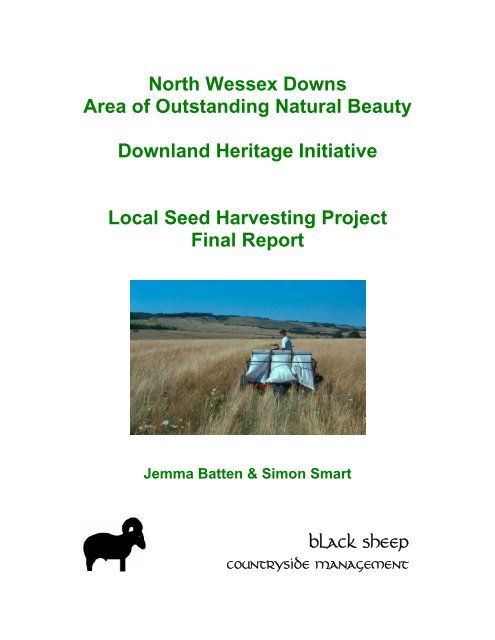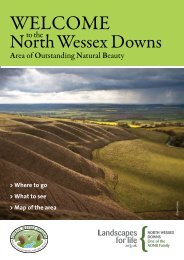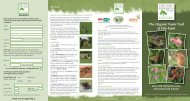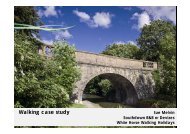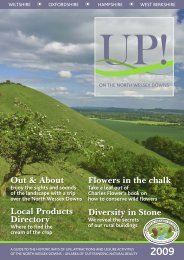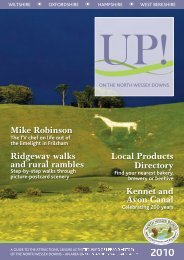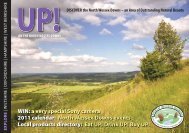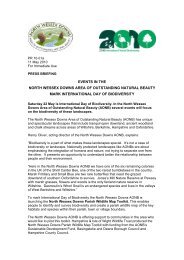North Wessex Downs Area of Outstanding Natural Beauty Downland ...
North Wessex Downs Area of Outstanding Natural Beauty Downland ...
North Wessex Downs Area of Outstanding Natural Beauty Downland ...
Create successful ePaper yourself
Turn your PDF publications into a flip-book with our unique Google optimized e-Paper software.
<strong>North</strong> <strong>Wessex</strong> <strong>Downs</strong><br />
<strong>Area</strong> <strong>of</strong> <strong>Outstanding</strong> <strong>Natural</strong> <strong>Beauty</strong><br />
<strong>Downland</strong> Heritage Initiative<br />
Local Seed Harvesting Project<br />
Final Report<br />
Jemma Batten & Simon Smart<br />
Black Sheep<br />
Countryside Management
<strong>North</strong> <strong>Wessex</strong> <strong>Downs</strong><br />
<strong>Area</strong> <strong>of</strong> <strong>Outstanding</strong> <strong>Natural</strong> <strong>Beauty</strong><br />
<strong>Downland</strong> Heritage Initiative<br />
Local Seed Harvesting Project<br />
Final Report<br />
Jemma Batten & Simon Smart<br />
Black Sheep Countryside Management<br />
5 The High Street – Rowde – Devizes – Wiltshire SN10 2NA<br />
Produced on behalf <strong>of</strong> the <strong>North</strong> <strong>Wessex</strong> <strong>Downs</strong> AONB Partnership<br />
with funding from <strong>Natural</strong> England<br />
The <strong>North</strong> <strong>Wessex</strong> <strong>Downs</strong> AONB was designated in 1972 to conserve and enhance its<br />
natural beauty.<br />
Black Sheep<br />
Countryside Management
DEVELOPMENT OF A<br />
LOCAL SEED HARVESTING NETWORK<br />
An Analysis <strong>of</strong> Management Issues and Infrastructural Needs<br />
1.0 Introduction<br />
The <strong>North</strong> <strong>Wessex</strong> <strong>Downs</strong> AONB’s Chalk Grassland Strategy (CGS) identified three key<br />
areas where targeted restoration and recreation <strong>of</strong> downland would bring maximum<br />
multiple benefits to landscape character, biodiversity and archaeology. These areas are<br />
the Horton <strong>Downs</strong>, the Hampshire <strong>Downs</strong>, and the Letcombe to Liddington Escarpment.<br />
Environmental Stewardship encourages the use <strong>of</strong> native and local seed for chalk<br />
grassland creation and restoration and a supplement for using native seed mixes is<br />
available which covers 100% <strong>of</strong> the costs.<br />
Thus it would appear that the requirement and therefore the market for seed harvested<br />
locally within the AONB will expand in future years.<br />
2.0 Survey<br />
All chalk grassland sites within the three target areas identified by the Chalk Grassland<br />
Strategy (see Figure 1 overleaf) were checked on the 1:25,000 Ordnance Survey map<br />
and some rejected without survey because they were obviously too steep for harvesting.<br />
Over the last eighteen months all remaining sites within the target areas have been<br />
surveyed for their seed harvesting potential. This was done using a rapid survey method<br />
(attached at Appendix 1) to assess each site according to slope, topography, anthills,<br />
accessibility, sward condition, weed species and scrub cover.<br />
Slope, topography, and anthill cover are physical characteristics <strong>of</strong> the sites which<br />
cannot be altered by site management so sites which did not meet requirements under<br />
these criteria were discarded. However, sward condition (unless agriculturally improved),<br />
weed species, scrub cover, and on some sites, accessibility, may be improved by good<br />
management. Thus even sites failing these criteria at the time <strong>of</strong> the survey could, with<br />
appropriate management, be suitable for harvesting at some time in the future.<br />
3.0 Sites<br />
The Chalk Grassland Strategy maps show 1926.88 ha <strong>of</strong> chalk grassland within the<br />
three target areas. Of this area 31 sites were identified across the three target areas as<br />
being potentially suitable for harvesting seed. Individual site record sheets are attached<br />
at Appendix 2. Many <strong>of</strong> these sites were variable and so were split into “Units”, each<br />
having more uniform characteristics. In total, 54 Units covering an approximate area <strong>of</strong><br />
571.85 ha were found to be potentially suitable for seed harvesting in the three target
Figure 1: <strong>North</strong> <strong>Wessex</strong> <strong>Downs</strong> AONB Local Seed Harvesting Project: Survey area and potential donor sites
areas. Of these 54 Units, 31 are Sites <strong>of</strong> Special Scientific Interest and 37 are believed<br />
to be managed under a “higher level” agri-environment scheme Agreement (Wildlife<br />
Enhancement Scheme, Countryside Stewardship Scheme or Higher Level<br />
Environmental Stewardship Scheme).<br />
3.1 Horton <strong>Downs</strong><br />
The majority <strong>of</strong> the survey work for this target area was carried out in the autumn <strong>of</strong> 2005<br />
as part <strong>of</strong> a pilot project during which the Rapid Survey scoring system and methodology<br />
were developed, though some sites were re-visited during the main project <strong>of</strong> 2006/07.<br />
The Horton <strong>Downs</strong> includes two distinct areas: the first running roughly from Devizes to<br />
east <strong>of</strong> Pewsey; and the second from north <strong>of</strong> Devizes to Beckhampton. These two<br />
areas were quite different in character, with the Devizes-Pewsey section being <strong>of</strong><br />
generally better quality grassland though on much steeper slopes, while the Devizes-<br />
Beckhampton section included some larger areas <strong>of</strong> accessible grassland, some <strong>of</strong><br />
which was good quality arable reversion. Neither section is particularly wooded.<br />
The Horton <strong>Downs</strong> target area contains fourteen sites (35 Units) covering up to 315 ha<br />
<strong>of</strong> potentially harvestable grassland. Seven <strong>of</strong> these sites (23 Units, ≈ 270 ha) are in the<br />
Devizes-Beckhampton section, and the remaining eight sites (12 Units, ≈ 45 ha) lie along<br />
the Pewsey scarp.<br />
3.2 Letcombe to Liddington Escarpment<br />
This target area was surveyed during autumn 2006 or spring 2007, and was found to be<br />
quite different from the Horton <strong>Downs</strong> in that there is far less chalk grassland. However,<br />
what there is, is generally restricted to small steeply sloping areas, with much <strong>of</strong> the<br />
more accessible areas having been agriculturally improved and in this way the area<br />
resembles somewhat the Devizes-Pewsey section <strong>of</strong> the Horton <strong>Downs</strong>.<br />
The Letcombe to Liddington Escarpment target area contains seven sites (7 Units)<br />
covering 93 ha <strong>of</strong> potentially harvestable grassland.<br />
3.3 Hampshire <strong>Downs</strong><br />
The most significant difference between this and the other two target areas is the higher<br />
proportion <strong>of</strong> woodland on the Hampshire <strong>Downs</strong>. Like the Horton <strong>Downs</strong>, this target<br />
area contains a good deal <strong>of</strong> chalk grassland though much <strong>of</strong> it is present only on<br />
inaccessible steep ground.<br />
The Hampshire <strong>Downs</strong> target area contains nine sites (12 Units) covering up to 40 ha <strong>of</strong><br />
potentially harvestable grassland.
Table 1: Summary <strong>of</strong> rapid survey results for chalk grassland sites in three target areas <strong>of</strong> the <strong>North</strong> <strong>Wessex</strong> <strong>Downs</strong> AONB<br />
Key: Minor management/harvesting issues which would not preclude harvesting if addressed<br />
Serious issues which would preclude harvesting at this time but could be addressed<br />
Target <strong>Area</strong> Site Unit Designation AE Flat area Topography Anthills Access Sward Weeds Scrub Score<br />
Hampshire<br />
<strong>Downs</strong><br />
Horton <strong>Downs</strong><br />
(Devizes to<br />
Pewsey)<br />
A SSSI, SAM CSS 19<br />
Beacon Hill<br />
B SSSI, SAM CSS 15<br />
C SSSI CSS 16<br />
D SSSI CSS 14<br />
Botley Down SSSI, SAM CSS 18<br />
Bunkhanger Copse CWS 13<br />
Combe Gibbet SSSI CSS 17<br />
Ladle Hill SSSI, SAM 17<br />
Rivar Down CWS 14<br />
The Temple SSSI CSS 18<br />
Wansdyke Farm CWS 17<br />
Woodcott Down CWS CSS 16<br />
All Cannings Down SAM CSS 17<br />
Cannings Cross SSSI 16<br />
Clifford's Hill<br />
A SSSI CSS 17<br />
B CSS 19<br />
Golden Ball Hill 20<br />
Walkers Hill<br />
A SSSI 18<br />
B SSSI, SAM 17<br />
Knap Hill C SSSI, SAM 18<br />
Milk Hill<br />
A SSSI 17<br />
B SSSI 20<br />
Woodborough Hill<br />
A CWS 21<br />
B CWS 19
Target <strong>Area</strong> Site Unit Designation AE Flat area Topography Anthills Access Sward Weeds Scrub Score<br />
Horton <strong>Downs</strong><br />
(Devizes to<br />
Beckhampton)<br />
Letcombe to<br />
Liddington<br />
Escarpment<br />
Beckhampton Gallops<br />
Calstone Down<br />
Cherhill Down<br />
King's Play Hill<br />
Horsecombe Bottom<br />
Morgan's Hill<br />
Roundway Down<br />
A CWS 16<br />
B CWS, SAM 21<br />
A SSSI CSS 19<br />
B SSSI CSS 15<br />
C SSSI CSS 15<br />
A SSSI CSS? 19<br />
B SSSI CSS? 18<br />
C SSSI, SAM CSS? 17<br />
D SSSI, SAM CSS? 19<br />
E SSSI, SAM CSS? 18<br />
A SSSI CSS 16<br />
B CWS CSS 13<br />
A CSS 21<br />
B CSS 19<br />
C SSSI CSS 19<br />
A SSSI, SAM CSS 16<br />
B SAM CSS 15<br />
C SAM CSS 21<br />
D SAM 18<br />
A CSS 18<br />
B CSS 20<br />
C CSS 20<br />
D SSSI, SAM CSS 20<br />
Hackpen Hill SSSI WES? 20<br />
Liddington Hill SAM CSS 17<br />
Liddington Warren 16<br />
Segsbury Castle SSSI, SAM CSS 21<br />
The Coombs SSSI CSS 15.5<br />
Uffington Castle SSSI, SAM CSS 20<br />
Warren Hill HLS 20
4.0 Site Constraints<br />
Table 1 (previous page) gives a summary <strong>of</strong> the sites and Units identified as being <strong>of</strong><br />
potential use for seed harvesting along with any constraints that may be <strong>of</strong><br />
significance on each site.<br />
4.1 Weed burden<br />
Following the original pilot survey <strong>of</strong> the Horton <strong>Downs</strong> the major factor identified as<br />
reducing the quality <strong>of</strong> otherwise suitable sites was the presence <strong>of</strong> injurious weed<br />
species. The survey <strong>of</strong> the Hampshire <strong>Downs</strong> confirmed the presence <strong>of</strong> weeds as a<br />
major barrier to site suitability.<br />
Of the 31 sites identified as having potential for seed harvesting 24 had weed cover<br />
that would preclude the harvesting <strong>of</strong> quality seed on at least some <strong>of</strong> the Units. The<br />
most common weed species were ragwort and spear thistle, with creeping thistle and<br />
nettles also occurring on some sites. Docks were generally more abundant on<br />
improved grassland areas but were less common on sites identified for seed<br />
harvesting.<br />
Interestingly, however, the presence <strong>of</strong> injurious weeds was not as significant along<br />
the Letcombe to Liddington Escarpment. This may be because <strong>of</strong> more intensive<br />
management practices in the Letcombe to Liddington target area leading to sward<br />
improvement <strong>of</strong> gentler slopes and greater control <strong>of</strong> injurious weed species in<br />
general.<br />
Even on sites with weeds distributed at a low density, seed harvesting should not be<br />
considered until the weeds have been controlled. Indeed, the transfer <strong>of</strong> injurious<br />
weed seed from a donor to a recipient site would be illegal under the Weeds Act<br />
1959 and could conflict with Cross Compliance GAEC11.<br />
4.1.1 Weed control training<br />
The control <strong>of</strong> weeds in “conservation” grassland was identified as a significant<br />
problem area during <strong>Downland</strong> Heritage Initiative stakeholder meetings. The<br />
observation that many potential harvesting sites are infested to a greater or lesser<br />
degree with injurious weeds further highlighted the need to support land managers in<br />
addressing this particular issue.<br />
Thus, a workshop was organised to focus attention on the control <strong>of</strong> injurious weeds<br />
in grassland where low intensity management requirements preclude the use <strong>of</strong><br />
generally applied (i.e. boom-sprayed) pesticides. The event covered the use <strong>of</strong> a<br />
variety <strong>of</strong> weed control techniques including cultural, mechanical and targeted<br />
chemical control.<br />
Following an introduction to the Local Seed Harvesting Project from Jemma Batten<br />
(Black Sheep Countryside Management), a presentation by Heather McCalman<br />
(IGER) described opportunities for managing weeds using cultural and mechanical<br />
techniques. The presentation covered grazing systems and sward management to<br />
prevent weed problems before they occur and to reduce existing weed burdens.<br />
Mechanical control including physical removal by pulling, both by hand and machine<br />
(ecopuller), and topping at the appropriate growth stage, was also considered.<br />
This was followed by a presentation by Ian Ball (<strong>Natural</strong> England) who described<br />
some <strong>of</strong> the chemical techniques available to those managing grassland in agri-
environment schemes. This included a summary <strong>of</strong> application methods such as<br />
weed wiping and spot spraying, and explanations <strong>of</strong> factors such as application rate<br />
and weed vigour which may affect control success. The benefits and limitations <strong>of</strong><br />
weedwipers, and management requirements prior to weed wiping were also covered.<br />
Both speakers emphasised the importance <strong>of</strong> understanding the lifecycles <strong>of</strong> the<br />
different weed species in order to optimise control both through choice <strong>of</strong> method and<br />
timing.<br />
The morning talks were followed by a display <strong>of</strong> a range <strong>of</strong> weed management<br />
equipment, during which participants had the opportunity to discuss the practicalities<br />
<strong>of</strong> weed management with the machinery owners and contractors.<br />
Those who attended the event were also provided with an extensive folder <strong>of</strong><br />
information on various aspects <strong>of</strong> weed control, including machinery suppliers,<br />
contractors’ details, thorough speakers’ notes and sources <strong>of</strong> further information.<br />
One <strong>of</strong> the issues highlighted previously was that many landowners who manage<br />
their chalk grassland under agri-environment schemes assume that there is very little<br />
opportunity to undertake weed management within the management prescriptions.<br />
One <strong>of</strong> the outcomes from the event was to show that there are a number <strong>of</strong><br />
proactive management opportunities for weed control within the bounds <strong>of</strong> agrienvironment<br />
grassland prescriptions.<br />
All land managers who were within the three target areas were invited and 22<br />
attended the weed control event. This included land managers for five sites which<br />
had been identified as suitable for harvesting seed. All five <strong>of</strong> these sites were also<br />
identified as having a weed problem. It is hoped that this event will have provided the<br />
managers <strong>of</strong> these sites with the skills, confidence, and contacts to address the weed<br />
issue.<br />
Those site owners and managers who did not attend have been contacted<br />
individually and provided with management advice including information on weed<br />
control where necessary.<br />
4.2 Scrub<br />
Scrub was identified on nine Units (seven sites) and on four <strong>of</strong> these Units was<br />
judged to be sufficient to preclude the harvesting <strong>of</strong> seed at present. The occurrence<br />
<strong>of</strong> scrub is most likely on more isolated difficult sites where suitable grazing regimes<br />
are not possible and/or where stock is not available (see section 4.4). Whilst initial<br />
scrub removal is essential it is equally important to continue long term control <strong>of</strong> the<br />
scrub by either continued mechanical and chemical control or by instigating an<br />
appropriate grazing regime.<br />
4.3 Agricultural improvement <strong>of</strong> sward<br />
Whilst the timing <strong>of</strong> the surveys prevented a full assessment <strong>of</strong> sward diversity, as<br />
highlighted in the site assessments some <strong>of</strong> the sites show a degree <strong>of</strong> agricultural<br />
improvement, whilst still supporting species indicative <strong>of</strong> more species rich chalk<br />
grassland.<br />
There may be an opportunity to enhance the condition <strong>of</strong> the existing chalk grassland<br />
resource by using seed from the most species rich sites. Not only will this improve<br />
the quantity and quality <strong>of</strong> future donor sites but, as stated in the Chalk Grassland
Strategy, management and enhancement <strong>of</strong> the existing resource should be the<br />
priority.<br />
Those sites showing some degree <strong>of</strong> improvement need to be surveyed at a more<br />
appropriate time <strong>of</strong> year to assess the level <strong>of</strong> improvement. It should be borne in<br />
mind that the diversity <strong>of</strong> grasses should be considered and not just diversity <strong>of</strong><br />
broad-leaved flowering plants. If necessary, it would be possible to add locally<br />
sourced seed <strong>of</strong> flowering plants to increase the number <strong>of</strong> species present once<br />
seed has been harvested from such sites.<br />
4.4 Lack <strong>of</strong> grazing<br />
The sward was classed as tussocky and under-managed on eight sites (ten Units),<br />
which may be a result <strong>of</strong> declining livestock numbers in the AONB. This is likely to<br />
be an increasing problem in the future particularly if predictions made following the<br />
introduction <strong>of</strong> the Single Farm Payment and the resulting loss <strong>of</strong> previous headage<br />
payments ring true. An ADAS survey funded by English Nature predicts a decline in<br />
lowland suckler cows <strong>of</strong> around 10%, although the report also suggests that sheep<br />
numbers may increase.<br />
Environmental Stewardship <strong>of</strong>fers some financial support for the maintenance <strong>of</strong><br />
appropriate grazing systems (Options EK5, HK5, HR1, and HR2) but this is unlikely<br />
to support livestock on a wider scale, particularly in the current funding situation.<br />
The grazing issue could also be addressed by promoting the involvement <strong>of</strong> owners<br />
<strong>of</strong> under-grazed sites with local grazing schemes including the Wiltshire Grazing<br />
Animals Programme (which is currently awaiting funding?) and the SheepKeep<br />
Website (http://www.sheepkeep.co.uk). Furthermore, as grazing problems are<br />
arguably the single most significant barrier to achieving “favourable condition” on<br />
SSSIs (a <strong>Natural</strong> England PSA target), on County Wildlife Sites, and on other<br />
undesignated though species-rich grasslands, it would seem sensible for each<br />
<strong>Natural</strong> England <strong>of</strong>fice to have a member <strong>of</strong> staff responsible for grazing issues<br />
within their area.<br />
4.5 Arable reversion<br />
At least four <strong>of</strong> the sites 1 contain areas <strong>of</strong> arable reversion managed under the<br />
Countryside Stewardship Scheme. These score highly due to their flat, even<br />
topography, which is obviously why they were originally ploughed. The reversion<br />
sites also lack anthills and scrub, as this has generally not had time to develop, at<br />
least on recent reversion.<br />
Even on reversion sites with currently poor species diversity, with appropriate longterm<br />
management these could potentially be good donor sites. However, this<br />
depends on the origin <strong>of</strong> the seed used to establish the grassland which, if<br />
inappropriate, may be a site constraint. It should be ensured that the seed source<br />
was local or that the sward developed from natural regeneration.<br />
5.0 Facilitation and meeting infrastructural requirements<br />
In order to further facilitate the harvesting <strong>of</strong> seed from the sites which have been<br />
identified as having potential, site managers need to be able to access details <strong>of</strong><br />
1 Unit C <strong>of</strong> Morgan’s Hill; Units A, B & C <strong>of</strong> Roundway Down; Liddington Hill; and Segsbury Castle.
those organisations and/or persons who can assist with practical management. This<br />
will enable them to address any management issues which are currently reducing the<br />
quality <strong>of</strong> the site for seed harvesting, primarily weed control and scrub management.<br />
To this end, a database <strong>of</strong> useful contractors would be useful.<br />
Table 2 provides contact details <strong>of</strong> contractors who undertake practical land<br />
management within the AONB.<br />
Table 3 provides the details <strong>of</strong> seed harvesting contractors who operate within the<br />
AONB. A sample seed harvesting contract, including guidance on best practice and<br />
health and safety, is attached at Appendix 3.<br />
In order to maximise the effectiveness <strong>of</strong> the Local Seed Project, the potential endusers<br />
<strong>of</strong> the project outputs need to be made aware <strong>of</strong> the resource. Table 4<br />
identifies potential users <strong>of</strong> the seed harvesting project outputs.
Table 2. Contractors who carry out scrub management and weed control within the AONB<br />
Company Contact name Address Telephone Mobile E-mail<br />
J & M Bodman<br />
BTCV<br />
Conservation<br />
Contractors<br />
John Cheke<br />
William<br />
Warden<br />
Knights Leaze<br />
Farm, Cuckoo<br />
Corner, Urchfont,<br />
Devizes, Wilts.<br />
SN10 4RA<br />
Sedum House,<br />
Mallard Way,<br />
Potteric Carr,<br />
Doncaster. DN4<br />
8DB<br />
Kepnal Farm<br />
Buildings, Kepnal,<br />
Pewsey, Wilts. SN9<br />
5JL<br />
End Farm, Marston,<br />
Devizes, Wilts.<br />
SN10 5SR<br />
01380<br />
840273<br />
01302<br />
388888<br />
01380<br />
726739<br />
07831<br />
839755<br />
07889<br />
461358<br />
Scrub<br />
Management<br />
<br />
Weed<br />
Control<br />
information@btcv.org.uk <br />
john.cheke@virgin.net<br />
info@conservationcontractors.co.uk<br />
Light scrub and<br />
follow up scrub<br />
clearance with<br />
mulcher<br />
<br />
<br />
<br />
Dryad Land and<br />
Tree Care Ltd.<br />
Matt Dry<br />
106 Anchor Road,<br />
Calne, Wilts. SN11<br />
8EB<br />
01249<br />
815186<br />
07967<br />
505624<br />
<br />
Dryad Tree<br />
Specialists<br />
Unit 19 Enterprise<br />
Estate, Noorfield<br />
Road, Guildford,<br />
Surrey. GU1 1RB<br />
01483<br />
455555<br />
<br />
Five Rivers<br />
Environmental<br />
Contracting<br />
Jason<br />
Lovering<br />
Ford Mill, Ford,<br />
Salisbury, Wilts.<br />
SP4 6EN<br />
01980<br />
610550<br />
jason@five-rivers.com <br />
John Hawkins<br />
3 Swedish Houses,<br />
Shalbourne,<br />
Marlborough, Wilts.<br />
SN8 3PX<br />
01672<br />
870934<br />
07970<br />
686876<br />
<br />
Disclaimer: Please note that no recommendation is made or should be implied from inclusion in the above table
Table 2. Contractors who carry out scrub management and weed control within the AONB<br />
Company Contact name Address Telephone Mobile E-mail<br />
<strong>Wessex</strong><br />
Woodland<br />
Management<br />
Ltd.<br />
Woodland and<br />
Garden Limited<br />
Mark Hooper<br />
Chris Denton<br />
Duncan<br />
Tough<br />
4 Manor Farm<br />
Cottages,<br />
Rockbourne,<br />
Fordingbridge,<br />
Hants. SP6 3NP<br />
Foxley Wood,<br />
Hungerford Park,<br />
Hungerford Road,<br />
Hungerford, Berks.<br />
RG17 0UT<br />
71 Park Farm,<br />
Seend Cleeve,<br />
Melksham, Wilts.<br />
SN12 6PX<br />
01488<br />
685007<br />
07971<br />
252519<br />
07717<br />
366405<br />
07779<br />
131563<br />
Scrub<br />
Management<br />
Weed<br />
Control<br />
mjhooper@globalnet.co.uk <br />
info@wessexwoodland.com <br />
<br />
<br />
Disclaimer: Please note that no recommendation is made or should be implied from inclusion in the above table
Table 3. Contractors who carry out seed harvesting within the AONB<br />
Company Contact name Address Telephone E-mail<br />
Alaska Environmental<br />
Contracting Ltd.<br />
Stokeford Farm,<br />
East Stoke,<br />
Wareham, Dorset,<br />
BH20 6AL<br />
01929 463301 will@alska.ltd.uk<br />
Emorsgate Seeds<br />
Richard Brown<br />
Limes Farm, Tilney<br />
All Saints, King's<br />
Lyn, Norfolk. PE34<br />
4RT<br />
01553 829028 enquiries@emorsgate-seeds.co.uk<br />
Sue Everett<br />
122 Derwent Road,<br />
Thatcham,<br />
Berkshire. RG19<br />
3UP<br />
01635 847164 suejeverett@hotmail.com<br />
Flower Farms<br />
Charles Flower<br />
Carvers Hill Farm,<br />
Shalbourne,<br />
Marlborough,<br />
Wiltshire, SN8 3PS<br />
01672 870782 flower.farms@farmersweekly.net<br />
Herbiseed Goring Gap<br />
Wildflowers<br />
New Farm, Mire<br />
Lane, Twyford,<br />
Berkshire. RG10<br />
0NJ<br />
0118 934464 s.morton@herbiseed.com<br />
Heritage Seeds<br />
Osmington,<br />
Weymouth, Dorset.<br />
DT3 6EX<br />
01305 834504 mail@hseeds.fsnet.co.uk<br />
Andrew<br />
Macdonald<br />
3 Coombe<br />
Cottages,<br />
Marlborough Road,<br />
Everleigh, Wiltshire<br />
1264850674 andrew.j.macdonald@btinternet.com<br />
Disclaimer: Please note that no recommendation is made or should be implied from inclusion in the above table
Table 4: Potential end users <strong>of</strong> Local Seed Project outputs (data and/or seed)<br />
Contact<br />
Organisation<br />
Address Telephone E-mail<br />
name<br />
Auborn<br />
Jude<br />
Buckland<br />
Rolfes House, 60 Milford Street,<br />
Salisbury, SP1 2BP<br />
01722<br />
426859<br />
jbuckland@auborn.com<br />
Berks, Bucks and<br />
Oxon Wildlife Trust<br />
The Lodge, 1 Armstrong Road,<br />
Littlemore, Oxford. OX4 4XT<br />
01865<br />
775476<br />
info@bbowt.org.uk<br />
Black Sheep<br />
Countryside<br />
Management<br />
Jemma<br />
Batten<br />
Simon Smart<br />
5 The High Street, Rowde, Devizes,<br />
Wiltshire. SN10 2NA<br />
4 White Horse Cottages, Bratton,<br />
Westbury, Wiltshire. BA13 4RS<br />
01380<br />
726043<br />
07748<br />
155143<br />
jemma.bat@btinternet.com<br />
simonsma@tiscali.co.uk<br />
Business Link,<br />
Berkshire and<br />
Wiltshire<br />
Tim Evans<br />
22 Bedwyn Street, Salisbury,<br />
Wiltshire. SP1 3UT<br />
0845<br />
6004141<br />
tim.evans@blbw.co.uk<br />
Chalkhill<br />
Environmental<br />
Consultants<br />
Janet Burnell<br />
Elm Tree Court, Long Street,<br />
Devizes, Wiltshire.<br />
01380<br />
726043<br />
janetburnell@wiltshriewildife.org<br />
Cleanacres Ltd<br />
Russell Frost<br />
Andoversford, Cheltenham,<br />
Gloucestershire. GL54 4LZ<br />
01242<br />
820481<br />
russell.frost@masstock.co.uk<br />
Countryside<br />
Service, Hampshire<br />
County Council<br />
The Castle, Winchester, Hampshire,<br />
SO23 8UJ<br />
01962<br />
841841<br />
info.centres@hants.gov.uk<br />
Disclaimer: Please note that no recommendation is made or should be implied from inclusion in the above table
Table 4: Potential end users <strong>of</strong> Local Seed Project outputs (data and/or seed)<br />
Organisation<br />
Countryside<br />
Service,<br />
Oxfordshire County<br />
Council<br />
Contact<br />
name<br />
Address Telephone E-mail<br />
Holton, Oxford, OX33 1QQ<br />
01865<br />
810226<br />
countryside@oxfordshire.gov.uk<br />
English Heritage<br />
Phil<br />
McMahon<br />
South West Region, 29 Queen<br />
Square, Bristol BS1 4ND<br />
0117 975<br />
0700<br />
phil.mcmahon@english-heritage.org.uk<br />
EnSynch<br />
Peter<br />
Carpenter<br />
<strong>North</strong> End, Wood Green,<br />
Fordingbridge. SP62AN<br />
01725<br />
512307<br />
petercarpenter@ensynch.co.uk<br />
Environment<br />
Agency<br />
Graham<br />
Scholey<br />
Thames Region, Isis House,<br />
Howberry Park, Wallingford, Oxon<br />
OX10 8BD<br />
01491<br />
828346<br />
graham.scholey@environomentagency.gov.uk<br />
Environment and<br />
Planning, West<br />
Berkshire Council<br />
Market Street, Newbury, West<br />
Berkshire, RG14 5LD<br />
01635<br />
42400<br />
info@westberks.gov.uk<br />
Environmental Land<br />
Management<br />
Jane<br />
Nordstrom<br />
30 Gravel Lane, Ringwood,<br />
Hampshire. BH24 1LN<br />
01425<br />
479417<br />
jane@elm-consultancy.co.uk<br />
Sue Everett<br />
122 Derwent Road, Thatcham,<br />
Berkshire, RG19 3UP<br />
01635<br />
847164<br />
valuingbiodiversity@ntlworld.com<br />
Farming and<br />
Wildlife Advisory<br />
Group (FWAG)<br />
Paul<br />
Holmes-Ling<br />
148 Chyngton Cottages, Eastbourne<br />
Road, Seaford, East Sussex, BN25<br />
4BJ<br />
01273<br />
490877<br />
paul.holmes-ling@fwag.org.uk<br />
Disclaimer: Please note that no recommendation is made or should be implied from inclusion in the above table
Table 4: Potential end users <strong>of</strong> Local Seed Project outputs (data and/or seed)<br />
Contact<br />
Organisation<br />
Address Telephone E-mail<br />
name<br />
FGC<br />
Vicky Cox<br />
Whitelands Cottage, Days Lane,<br />
Kington Langley, Chippenham,<br />
Wiltshire. SN15 5PD<br />
Forestry<br />
Commission<br />
Ian Briscoe<br />
Forestry Commission, Postern Hill<br />
Lodge, Marlborough, Wiltshire SN8<br />
4ND<br />
01672<br />
511767<br />
ian.briscoe@forestry.gsi.gov.uk<br />
Great Western<br />
Community Forest<br />
Patrick<br />
Norris<br />
1st Floor, Premier House, Station<br />
Road, Swindon SN1 1T2<br />
01793<br />
466324<br />
pnorris@swindon.gov.uk<br />
Hampshire<br />
Biodiversity<br />
Information Centre<br />
Nicky Court<br />
Ashburton Court West, The Castle,<br />
Winchester, SO23 8UE<br />
01962<br />
845046<br />
nicky.court.hbic@hants.gov.uk<br />
Hampshire Wildlife<br />
Trust<br />
Beechcr<strong>of</strong>t House, Vicarage Lane,<br />
Curdridge, Hampshire, SO32 2DP<br />
01489<br />
774400<br />
feedback@hwt.org.uk<br />
Hutchinsons<br />
Colin Watts<br />
Double Hedges, Andover Road,<br />
Chirton, Devizes, Wiltshire. SN10<br />
3QL<br />
01380<br />
840040<br />
colinwatts@hutchinsons.co.uk<br />
Just Ecology<br />
Eleanor<br />
Hewins<br />
Woodend House, Woodend,<br />
Wootton under Edge,<br />
Gloucestershire. GL12 8AA<br />
01453<br />
811780<br />
eleanor@justecology.co.uk<br />
Kennet District<br />
Council<br />
Will Harley<br />
Kennet District Council, Browfort,<br />
Bath Road, Devizes, Wiltshire SN10<br />
2AT<br />
01380<br />
724911<br />
will.harley@kennet.gov.uk<br />
Disclaimer: Please note that no recommendation is made or should be implied from inclusion in the above table
Table 4: Potential end users <strong>of</strong> Local Seed Project outputs (data and/or seed)<br />
Contact<br />
Organisation<br />
Address Telephone E-mail<br />
name<br />
Kynet Consultancy<br />
Gill Swanton<br />
<strong>North</strong> Farm, West Overton,<br />
Marlborough, Wiltshire. SN8 1QE<br />
grswanton@aol.com<br />
Lane Fox<br />
Fiona Yarrow<br />
15 Dyer Street, Cirencester,<br />
Gloucestershire. GL7 2PP<br />
01285<br />
659661<br />
enquiries@lanefox.co.uk<br />
National Farmers<br />
Union<br />
Denise<br />
Plummer<br />
Leaze Farm, Stanton St. Quintin,<br />
Chippenham, Wiltshire SN14 6DQ<br />
01666<br />
837250<br />
denise.plummer@gmail.com<br />
National Trust<br />
Chris Gingell<br />
Wiltshire Countryside Office, West<br />
Kennet Farm, West Kennet,<br />
Marlborough, Wiltshire SN8 1QF<br />
01672<br />
539167<br />
christopher.gingell@nationaltrust.org.uk<br />
<strong>Natural</strong> England<br />
Tim Frayling<br />
Prince Maurice Court, Hambleton<br />
Avenue, Devizes, Wiltshire SN10<br />
2RT<br />
01380<br />
725670<br />
tim.frayling@naturalengland.org.uk<br />
<strong>Natural</strong> England<br />
Stephanie<br />
Payne<br />
Block 3, Burghill Road, Westburyon-Trym,<br />
Bristol BS10 6NJ<br />
0117 959<br />
1000<br />
stephanie.payne@naturalengland.org.uk<br />
Jonathan<br />
Olver<br />
36 The Grove, Hayles Road,<br />
Cheltenham, Gloucestershire, GL52<br />
6SX<br />
01242<br />
260310<br />
email@jonathanolver.co.uk<br />
RSPB<br />
Julia<br />
Gallagher<br />
Enterprise House, Cherry Orchard<br />
Lane, Salisbury, Wiltshire SP2 7LD<br />
01722<br />
427251<br />
julia.gallagher@rspb.org.uk<br />
Disclaimer: Please note that no recommendation is made or should be implied from inclusion in the above table
Table 4: Potential end users <strong>of</strong> Local Seed Project outputs (data and/or seed)<br />
Contact<br />
Organisation<br />
Address Telephone E-mail<br />
name<br />
Thames Valley<br />
Environmental<br />
Records Centre<br />
Adrian<br />
Hutchings<br />
TVERC Berkshire, c/o Council<br />
Offices, Market Street, Newbury,<br />
Berks RG14 5LD<br />
01635<br />
519179<br />
AHutchings@westberks.gov.uk<br />
West Berkshire<br />
Heritage Service<br />
Duncan Coe<br />
The Wharf, Newbury, Berkshire.<br />
RG14 5AS<br />
01635 30511 heritage@westberks.gov.uk<br />
Wiltshire and<br />
Swindon<br />
Biodiversity<br />
Records Centre<br />
Purgle<br />
Linham<br />
Elm Tree Court, Long Street,<br />
Devizes, Wiltshire, SN10 1NJ<br />
01380<br />
725670<br />
purgleL@wiltshirewildlife.org<br />
Wiltshire<br />
Archaeology<br />
Service<br />
Sue Farr<br />
Wiltshire County Council, County<br />
Hall, Trowbridge, Wiltshire BA14<br />
8JD<br />
suefarr@wiltshire.gov.uk<br />
Wiltshire County<br />
Council<br />
Steve<br />
Russell<br />
Countryside Manager (Landscape),<br />
Wiltshire County Council,<br />
Environmental Services Department,<br />
County Hall, Trowbridge, Wiltshire<br />
BA14 8JD<br />
01225<br />
713425<br />
steverussell@wiltshire.gov.uk<br />
Wiltshire Wildlife<br />
Trust<br />
Rob Large<br />
Wiltshire Wildlife Trust, Elm Tree<br />
Court, Long Street, Devizes,<br />
Wiltshire SN10 1NJ<br />
01380<br />
725670<br />
roblarge@wiltshirewildlife.org<br />
Disclaimer: Please note that no recommendation is made or should be implied from inclusion in the above table
Appendix 1: Site assessment for seed harvesting and/or hay making<br />
1. Slope<br />
All land on steep (>1 in 6) slope<br />
Site includes an area <strong>of</strong> flat* land > 0.5 ha Score 2<br />
Site includes an area <strong>of</strong> flat land >1 ha Score 3<br />
* Accessible with seed harvesting/hay making equipment<br />
2. Topography<br />
Earthworks or other significantly uneven ground across<br />
large areas which would either preclude harvesting/hay<br />
making entirely or significantly reduce the available area*.<br />
<strong>Area</strong>s <strong>of</strong> uneven ground are not sufficient to preclude<br />
seed harvesting or hay making though field operations<br />
may need to be undertaken with more care.<br />
Ground is uneven only in discrete areas (e.g. chalk pits,<br />
lynchets) which may be avoided without significantly<br />
reducing the available area.<br />
Site not suitable - reject<br />
Site not suitable - reject<br />
Score 2<br />
Score 2<br />
The ground across the entire site is relatively even. Score 3<br />
* To less than 0.5 ha.<br />
3. Anthills<br />
Frequent anthills (
5. Sward condition<br />
Sward agriculturally improved over much or all <strong>of</strong> site.<br />
Sward significantly over-grazed, and/or poached.<br />
Sward tussocky and/or seriously under-managed or<br />
unmanaged.<br />
Evidence <strong>of</strong> species diversity; relatively uniform structure<br />
across harvestable area.<br />
Site not suitable – reject<br />
Site currently not<br />
suitable but has future<br />
potential.<br />
Score 2<br />
Score 3<br />
6. Weed species<br />
Injurious weeds* present, even at low density, across<br />
large areas.<br />
Injurious weeds and /or nettles restricted to specific<br />
patches which could be avoided without significantly<br />
reducing the available area.<br />
Site currently not<br />
suitable but has future<br />
potential<br />
Score 2<br />
Few or no injurious weeds or nettles. Score 3<br />
* Ragwort, creeping thistle, spear thistle, curled dock, broadleaved dock<br />
7. Scrub cover<br />
Scrub blocking access points or key links between<br />
harvestable areas.<br />
Scrub distributed across more than 50% <strong>of</strong> site with<br />
scattered areas <strong>of</strong> grassland within more or less dense<br />
scrub.<br />
Scrub cover would not preclude seed harvesting or hay<br />
making nor significantly reduce the available area.<br />
Scrub absent or present only as widely scattered bushes<br />
(


